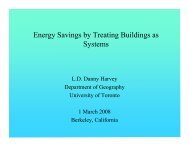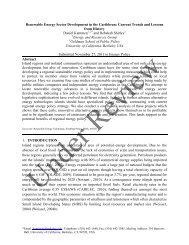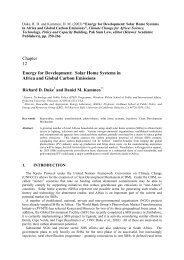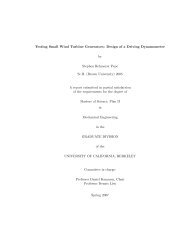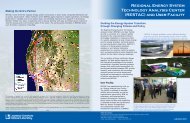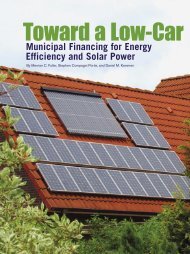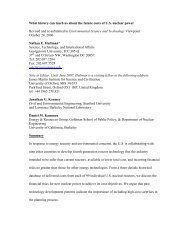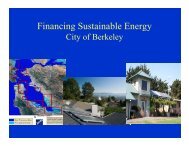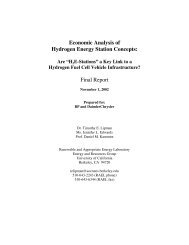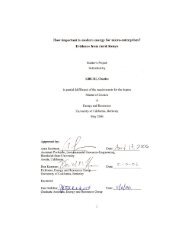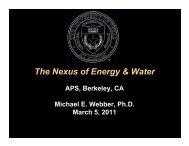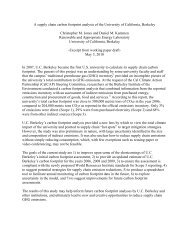Informing the Financing of Universal Energy Access: An Assessment ...
Informing the Financing of Universal Energy Access: An Assessment ...
Informing the Financing of Universal Energy Access: An Assessment ...
You also want an ePaper? Increase the reach of your titles
YUMPU automatically turns print PDFs into web optimized ePapers that Google loves.
ELECTR-5744; No <strong>of</strong> Pages 26implementation <strong>of</strong> <strong>the</strong> project and acommitment to buy a specifiedquantity <strong>of</strong> CERs (typically at adiscounted price) once <strong>the</strong>y have beenissued. The project participants ownany remaining CERs and can sell <strong>the</strong>mat <strong>the</strong> market price. Thus an ERPAprovides some initial funding and canserve as security for loans (based on<strong>the</strong> revenue from <strong>the</strong> commitment topurchase CERs). O<strong>the</strong>r possiblesources <strong>of</strong> foreign funding for <strong>the</strong>investment are: (1) credit provided byforeign equipment suppliers and (2)loans from foreign lenders. So forunilateral projects <strong>the</strong> sources <strong>of</strong> <strong>the</strong>funds invested are likely to beprimarily domestic, with <strong>the</strong> mainexception being any initial paymentsunder an ERPA. See Lütken andMichaelowa (2008) for fur<strong>the</strong>rjustification <strong>of</strong> this assertion.41. UNFCCC (2010).42. Since this article focus on energyaccess <strong>the</strong> following project types wereexcluded: Agriculture, Cement, CO 2usage, Coal bed/mine methane, EEindustry, EE own generation, EEservice, Forests, Fugitive, HFCs, N 2 O,PFCs, SF 6 , and Transport. For Fossilfuel switch only new natural gaspower plant are included; for Landfillgas, and Methane avoidance onlypower producing projects areincluded (however, <strong>the</strong> six householdprojects producing biogas for cookingare included).43. This document has been producedwithout formal United Nationsediting. The designations employedand <strong>the</strong> presentation <strong>of</strong> <strong>the</strong> material inthis document do not imply <strong>the</strong>expression <strong>of</strong> any opinion whatsoeveron <strong>the</strong> part <strong>of</strong> <strong>the</strong> Secretariat <strong>of</strong> <strong>the</strong>United Nations IndustrialDevelopment Organizationconcerning <strong>the</strong> legal status <strong>of</strong> anycountry, territory, city or area or <strong>of</strong> itsauthorities, or concerning <strong>the</strong>delimitation <strong>of</strong> its frontiers orboundaries, or its economic system ordegree <strong>of</strong> development. Designationssuch as ‘‘developed,’’‘‘industrialized,’’ and ‘‘developing’’are intended for statisticalconvenience and do not necessarilyexpress a judgment about <strong>the</strong> stagereached by a particular country or areain <strong>the</strong> development process.26 1040-6190/$–see front matter # 2011 Elsevier Inc. All rights reserved., doi:/10.1016/j.tej.2011.07.006 The Electricity JournalPlease cite this article in press as: Bazilian M, have surnames. <strong>Informing</strong> <strong>the</strong> <strong>Financing</strong> <strong>of</strong> <strong>Universal</strong> <strong>Energy</strong> <strong>Access</strong>: <strong>An</strong> <strong>Assessment</strong> <strong>of</strong> Current Financial FlowsElectr. J. (2011), doi:10.1016/j.tej.2011.07.006



